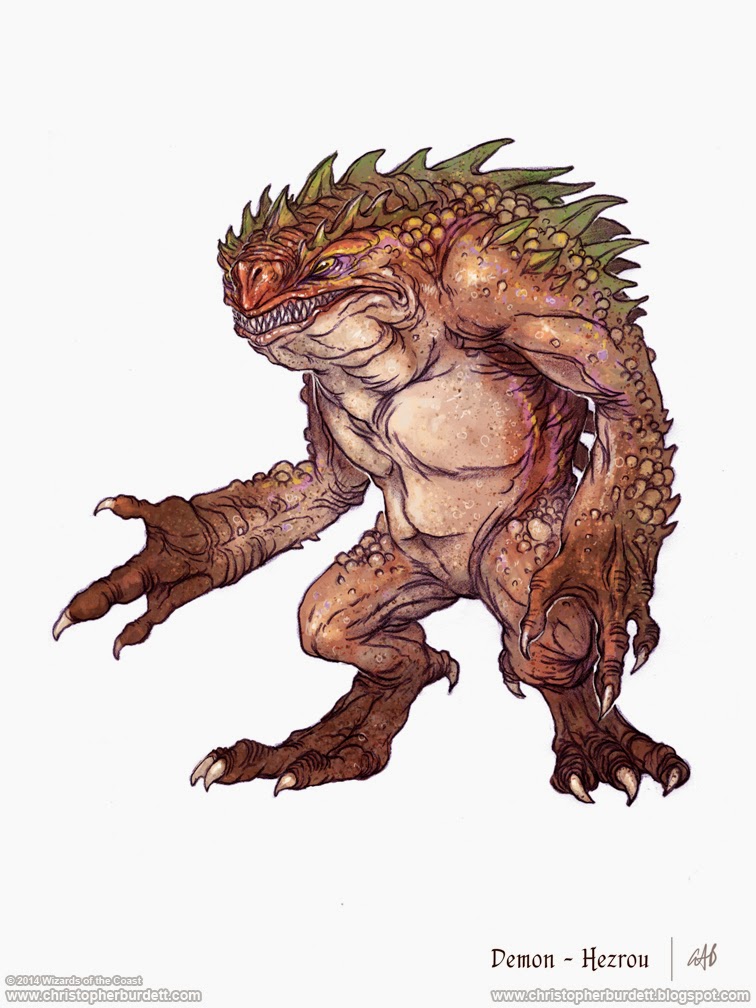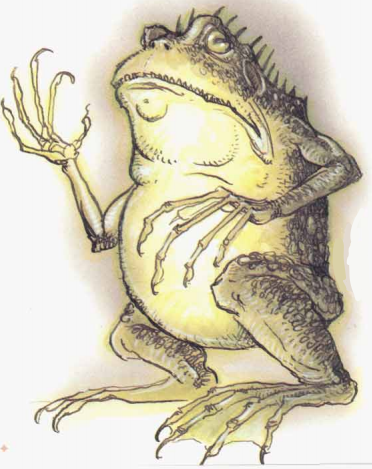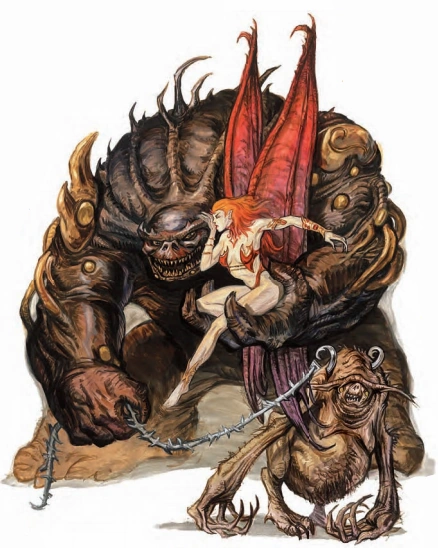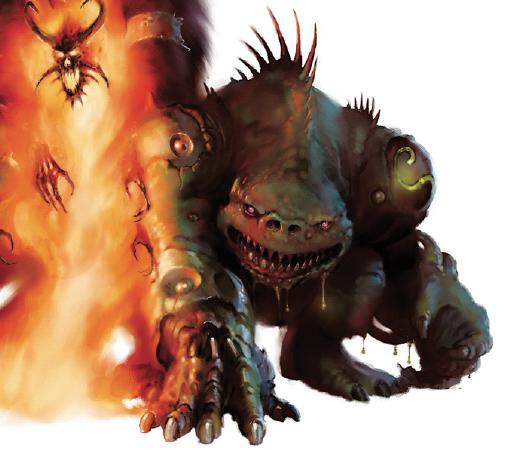Quickleaf
Legend
Back in 2014 Christopher Burdett shared his design sketches for a redesign of the hezrou demon. He describes it as a "giant fat frog demon", like several Monster Manuals have done, and while his artwork is terrific, the end product looks very much like a slaad... with more spikes. This was the final concept that informed the 5e Monster Manual art.

I've been working on an adventure involving demons, and realized that 5e’s take on the hezrou falls really flat. It's essentially a bigger version of a stinky dretch. A big sack of HP that’s described as a “foot soldier” with negligible lore. Even the brutish barlgura – which fills a very similar “foot soldier” role – is more mechanically interesting. So I'm going to redesign this demon, keeping the essence of the monster but making it more interesting artistically, lore-wise, and mechanically.
Do you have any suggestions for the hezrou's artistic representation, lore, or mechanics? Things that you've done with it in your own games?
In the spoiler below, I go through the hezrou demon in each edition of D&D from 1e to 5e, so you can follow my design thinking.


1e: Monster Manual
Art: The “Type II” demon looks like a twisted chubby big-mouthed lizardman that’s dancing.
Lore:

2e: Planescape Monstrous Compendium Appendix
Art: The Diterlizzi art doubles down on the frog-ish look and gives it an even larger mouth.
Lore:

3.5e: Monster Manual
Art: In this edition, the hezrou looks more like a hulking brute with glowering eyes underneath spiky brows, growths and spikes growing over its body. Its mouth remains wide.
Lore:
Mechanics:

4e: Monster Manual
Art: Pretty much identical to 3.5e.
Lore:

5e: Monster Manual
Art: Looks alot like a spikier take on a bulky slaad. Like the slaad, it has a wide mouth.
Lore:
Mechanics:
I am still playing with some sketches, but here's what I've come up with regarding its lore and mechanics. Trying to keep my changes as effective and minimally invasive to the existing stat block as possible.
Lore:
Mechanics: Innate Spellcasting
If barlgura can have Innate Spellcasting, so can the hezrou…or if not spellcasting, then special/magical abilities. I’m going through each spell it got in older editions to evaluate the spell against the “demonic sergeant” theme.
First, it's an action to activate. That means the hezrou forgoes its first round of claw/claw/bite (37 average damage). A character moving through the Caustic Miasma takes 14 (4d6) acid damage. It seems rare to find a party that doesn't have two characters who engage in melee on the regular, so if a party braves the miasma that is 28 acid damage. In this case, the hezrou may have sacrificed a little bit of damage (but maybe not - see below). However, if three characters brave the Caustic Miasma that jumps up to 42 acid damage, which eclipses the hezrou's single-round damage. Which is why I dropped its HP just to be safe.
There are a couple ways to deal with Caustic Miasma – dispel magic works because it's a magical effect, gust of wind could blow it away, or dealing a lot of damage to the hezrou (either via a Sharpshooter, adding advantage to a ranged attack to negate disadvantage, or a spell requiring a save). However, the damage route is hard because the hezrou has +8 CON, so even 36 damage would be a DC 18 Con save, giving the hezrou a 50/50 chance. Or you could lure the hezrou into overextending itself / its forces, withdraw briefly, and then mount a followup attack after it drops the concentration thinking the battle was over.
The size (20-ft radius) is intended to prevent melee characters from being able to move and attack in the same round, unless they have freedom of movement or haste, are a rogue using Cunning Action, a fighter using Action Surge, a 5th level barbarian, a monk, are a race with 40 speed or speed features (e.g. tabaxi). If a character moves adjacent to the hezrou but wasn't able to attack in the same turn, the hezrou will have its dretches or whatever minions push past those characters, deliberately provoking opportunity attacks. The hezrou does this because it wants to claw/claw/bite, then move back 20 feet without provoking. Now, the characters are faced with the prospect of having to reenter the Caustic Miasma for more damage.

5e Monster Manual said:Hezrous serve as foot soldiers in the demonic hordes of the Abyss. Although physically powerful, they are weakminded and hezrous can easily be duped into sacrificing themselves by more powerful demons. As they press their attacks into the heart of an enemy's forces, their foul stench can sicken even the toughest foes.
I've been working on an adventure involving demons, and realized that 5e’s take on the hezrou falls really flat. It's essentially a bigger version of a stinky dretch. A big sack of HP that’s described as a “foot soldier” with negligible lore. Even the brutish barlgura – which fills a very similar “foot soldier” role – is more mechanically interesting. So I'm going to redesign this demon, keeping the essence of the monster but making it more interesting artistically, lore-wise, and mechanically.
Do you have any suggestions for the hezrou's artistic representation, lore, or mechanics? Things that you've done with it in your own games?
In the spoiler below, I go through the hezrou demon in each edition of D&D from 1e to 5e, so you can follow my design thinking.

1e: Monster Manual
Art: The “Type II” demon looks like a twisted chubby big-mouthed lizardman that’s dancing.
Lore:
- They’re depicted as having low Intelligence, much like the vrock.
- There really is no lore to speak of here.
- They can be struck by normal weapons. Besides that, there’s not much here.
- They can cast several spells at-will, but none of these are unique. Darkness (most 1e demons can do this), detect invisible objects (e.g. so can 1e’s balor, marilith, and vrock), fear (so can 1e’s balor glabrezu, nalfeshnee, and marilith), levitate (so can 1e’s glabrezu), and telekinesis (so can both 1e’s glabrezu, nalfeshnee, and vrock).

2e: Planescape Monstrous Compendium Appendix
Art: The Diterlizzi art doubles down on the frog-ish look and gives it an even larger mouth.
Lore:
- They’re depicted as having average to high Intelligence (8 - 14). By comparison, the barlgura is low to average Intelligence (5 - 10), and the vrock is high (12 - 14).
- They oversee formation of Abyssal armies at the behest of their masters – nalfeshneee, true tanar’ri, and demon lords. They’re depicted like sergeants who keep the rowdy lesser demons in line.
- There’s a fascinating bit about “Dark Walks.” Certain times in a century, a hezrou can plane shift at will, and then it goes forth to make simple pacts with mortals. They enter into service to a mortal in dire need (e.g. destroying an enemy’s castle or retrieving a lost artifact), and in exchange the mortal (or a betrayed family member, friend, or lover) is taken to the Abyss to serve forever as a mane.
- They grab anyone they hit with both attacks – maybe to keep deserters from fleeing or to capture new recruits?
- They exude a a foul liquid from their skin that induces gagging and vomiting in anyone within 10 feet.
- They can cast a host of unique spells. Some play with the laws of physics – animate object, blink, duo-dimenion, and protection from normal missiles. Others are more Old Testament, I guess you could say – produce flame, summon insects, unholy word, and wall of fire.

3.5e: Monster Manual
Art: In this edition, the hezrou looks more like a hulking brute with glowering eyes underneath spiky brows, growths and spikes growing over its body. Its mouth remains wide.
Lore:
- They depicted as Intelligence 14, but their cunning is limited to battlefield strategies. By comparison, the bar-lgura in the Book of Vile Darkness are Intelligence 13, whereas the vrock are Intelligence 14.
- They’re “demonic sergeants” literally, overseeing formation of armies and commanding units in battle.
Mechanics:
- They have a host of skills as was typical of the edition, with stand-outs being climb, concentration, intimidate, listen, and spot.
- They have stench, very similar to their AD&D version.
- They grab anyone they hit with both attacks, like their AD&D version.
- They can, like their AD&D version, cast several unique spells: chaos hammer & unholy blight (which the 3.5e glabrezu also has), blasphemy (which 3.5e balor also has), and 3.5e introduces gaseous form 3/day. Most of these spells lay down damage and/or disable, more like the “Old Testament” spells of the 2e version. However, gaseous form is both interesting and perplexing…why would a “demonic sergeant” need to seep through walls as a gas?

4e: Monster Manual
Art: Pretty much identical to 3.5e.
Lore:
- They depicted as Intelligence 8, with an emphasis on being obedient. By comparison the barlgura are Intelligence 6, and vrock are Intelligence 12.
- They live to serve stronger demons & summoners who reward/encourage their destructive behavior.
- They are motivated by food.
- They have a stench aura that imposes a penalty to hit and weakens. So a bit tuned down from past editions.
- They can ignore difficult terrain, “seeming to phase through it.” This evokes the 3.5e gaseous form spell.
- Like most of 4e’s monsters they have no spellcasting.
5e: Monster Manual
Art: Looks alot like a spikier take on a bulky slaad. Like the slaad, it has a wide mouth.
Lore:
- They are depicted as Intelligence 5, lower than the bar-lgura (7) and lowest it’s ever been depicted in any edition of D&D. They’re “weakminded” and “easily duped into sacrificing themselves by more powerful demons.”
- They are “foot soldiers” (downgraded from being sergeants in 3e and 2e)
Mechanics:
- They have the stench aura which is comparable with the 4e version. And that’s it.
I am still playing with some sketches, but here's what I've come up with regarding its lore and mechanics. Trying to keep my changes as effective and minimally invasive to the existing stat block as possible.
Lore:
- They’re no strategic geniuses, but they have low cunning on par with a kobold (sufficient to lure enemies into a trap). Intelligence 5 seems too low. 8 is more in line with how I see them, comparable to a vrock.
- This helps reflect their “demonic sergeant” role. While they can still be powerful brutes, I want to play up this part of their identity which seems to have fallen by the wayside. 5e doesn’t describe any demon as being the “squad leader”, just mariliths commanding demonic hordes, so restoring this aspect of the hezrou fills a gap. Hezrou lead from the front.
- The 2e bit about “Dark Walks” is great and makes hezrous a bit like evil recruiters, not in the tricky sense of a succubus, but in a very transparent bargain: “yes, I can do this for you, but after a ten-year, you will serve forever in the army of the Abyss.”
- They have a ton of HP - 136. This is the same as a CR 8 young green dragon or tyrannosaurus rex! And the hezrou has damage resistance to bludgeoning, piercing, and slashing weapons to boot, which according to the DMG give it 204 effective HP! To be fair the CR 8 frost giants have 138 HP and CR 8 hydra have 178 HP, so there is precedent, but mostly these are Huge creature (excepting the young green dragon – but that’s a dragon). A good comparison might be the large CR 8 green slaad with 127 HP and no B/P/S resistances (but does have regeneration giving it 157 effective HP). Right now, their hit points sit squarely between a CR 6 vrock (104) than a CR 9 glabrezu (157!), which is relationally the same as the AD&D versions with 8 HD vrocks, 9 HD hezrou, and 10 HD glabrezu. I may drop this down to 116-130 to lower the hezrous defensive CR slightly in order to bump its offensive CR slightly while keeping its total CR 8.
- Probably best not to try to incorporate the Improved Grab stuff, since the 5e glabrezu already grapples with its pincer. It doesn’t seem essential to the hezrou’s core concept.
- I think the hezrou needs another trait/action, and though I was originally thinking Innate Spellcasting, as you’ll see in my examinatino of each spell hezrou have had in older editions, probably spellcasting isn’t the right fit, but the spells can be used to inform a new special ability.
Mechanics: Innate Spellcasting
If barlgura can have Innate Spellcasting, so can the hezrou…or if not spellcasting, then special/magical abilities. I’m going through each spell it got in older editions to evaluate the spell against the “demonic sergeant” theme.
- The physics-altering spells of AD&D like animate object, blink, and duo-dimenion, don’t seem to fit – these seem better suited to a banderhobb or some other boogeyman out of a fairy tale who jump scares you. Blink and duo-dimension have an element of evasion to them, however, so keeping that in the back of my mind.
- However, protection from normal missiles would make sense if if protected more than one creatures. That would make it easier for a squad of demons to close to melee. There’s no 5e version of this spell, but a way to represent it might be attaching heavy obscurement to the hezrou’s Stench cloud in some way. I think this will be a thread I lean into.
- The “Old Testament” spells from AD&D are produce flame, summon insects, unholy word, and wall of fire. Right away, I’m nixing produce flame because the hezrou really isn’t a ranged combatant. Also, hezrou can summon dretches already so no need for summon insects (plus it’s kind of off theme). While wall of fire would be a cool strategic spell on a battlefield, it never became something hezrou were known for, could significantly boost their CR with ongoing damage, and their Stench already exerts a bit of battlefield control. Unholy word becomes blasphemy in 3e, so I’ll address that next.
- The “Old Testament” spells from 3e are blasphemy, chaos hammer, and unholy blight. Well, unholy word/blasphemy kind of fits a demonic imagining of a drill sergeant, though there’s no exact 5e equivalent and the matter of targeting is complicated (e.g. if it affected non-evil creatures, well, normally the hezrou is engaged in the Blood War which is against lawful evil devils, so…). It was also a spell the 3.5e balor had, but the 5e balor gets no such spell. So putting it in my back pocket for now.
- Chaos hammer and unholy blight were shared with the glabrezu in 3.5e, but unleashing area effect destruction was never the glabrezu’s thing – it was more about corrupting spellcasters, and it’s 5e spells like confusion, dispel magic, and power word stun reflect that. The hezrou, on the other hand, IS about battlefield magic. Chaos hammer does area damage and slows; while there is no exact 5e equivalent, the idea that a hezrou makes it easier for its troops to bypass difficult terrain goes hand-in-hand with the idea of making it harder for enemies to cross difficult terrain (which is like a lesser slow effect). I think that’s something I can expand on. Unholy blight targets non-evil creatures and damages + sickens (the latter which the hezrou already does with Stench), so maybe not the best fit for a 1:1 conversion; however, the spell description is “a cold, cloying miasma of greasy darkness.” I’m going to lean on that.
- Gaseous form has me thinking. Even though it doesn’t fit the hezrou’s role, what if the hezrou has a trait/action which protects its troops (protection from normal missiles) and “slipstreams” them across difficult terrain surrounded by “a cold, cloying miasma of greasy darkness”? And what if this heavy obscurement rolling from its Stench cloud makes movement harder for hostile forces? THAT sounds perfect for the hezrou. It merges several older edition ideas and gives mechanical support to hezrou being squad leaders.
- Increase Intelligence to 8.
- Decrease Hit Points to 126 (12d10+60).
- Caustic Miasma (recharges after a short or long rest). Magical dark greasy whirling vapors fill a 20-foot radius sphere around the hezrou and move with it. Ranged attacks made from within this miasma, as well as ranged attacks made against creatures within this miasma, have disadvantage. Demons in the miasma ignore difficult terrain. Creatures hostile to the hezrou must spend an additional 5 feet of movement for every space within the miasma they move through, and take 1d6 acid damage for every 5 feet they move through the miasma toward the hezrou. The miasma lasts as long as the hezrou maintains concentration or until strong winds displace it.
First, it's an action to activate. That means the hezrou forgoes its first round of claw/claw/bite (37 average damage). A character moving through the Caustic Miasma takes 14 (4d6) acid damage. It seems rare to find a party that doesn't have two characters who engage in melee on the regular, so if a party braves the miasma that is 28 acid damage. In this case, the hezrou may have sacrificed a little bit of damage (but maybe not - see below). However, if three characters brave the Caustic Miasma that jumps up to 42 acid damage, which eclipses the hezrou's single-round damage. Which is why I dropped its HP just to be safe.
There are a couple ways to deal with Caustic Miasma – dispel magic works because it's a magical effect, gust of wind could blow it away, or dealing a lot of damage to the hezrou (either via a Sharpshooter, adding advantage to a ranged attack to negate disadvantage, or a spell requiring a save). However, the damage route is hard because the hezrou has +8 CON, so even 36 damage would be a DC 18 Con save, giving the hezrou a 50/50 chance. Or you could lure the hezrou into overextending itself / its forces, withdraw briefly, and then mount a followup attack after it drops the concentration thinking the battle was over.
The size (20-ft radius) is intended to prevent melee characters from being able to move and attack in the same round, unless they have freedom of movement or haste, are a rogue using Cunning Action, a fighter using Action Surge, a 5th level barbarian, a monk, are a race with 40 speed or speed features (e.g. tabaxi). If a character moves adjacent to the hezrou but wasn't able to attack in the same turn, the hezrou will have its dretches or whatever minions push past those characters, deliberately provoking opportunity attacks. The hezrou does this because it wants to claw/claw/bite, then move back 20 feet without provoking. Now, the characters are faced with the prospect of having to reenter the Caustic Miasma for more damage.
Last edited:
